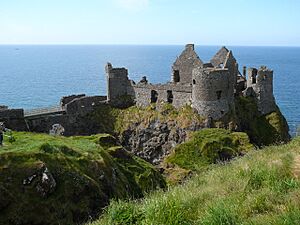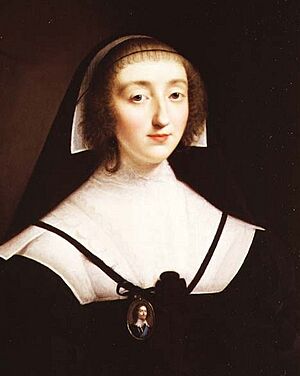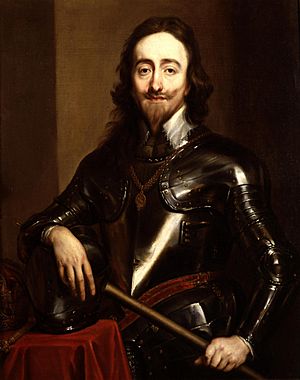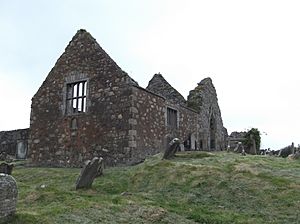Randal MacDonnell, 1st Marquess of Antrim (1645 creation) facts for kids
Quick facts for kids
Randal MacDonnell
|
|
|---|---|
| Marquess of Antrim | |
 |
|
| Tenure | 1636–1683 |
| Predecessor | Randal, 1st Earl of Antrim |
| Successor | Alexander, 3rd Earl of Antrim |
| Born | 1609 |
| Died | 3 February 1683 (aged 74) Dunluce, Ireland |
| Buried | Bonamargy Friary, Ballycastle |
| Spouse(s) |
|
| Father | Randal, 1st Earl of Antrim |
| Mother | Alice O'Neill |
Randal MacDonnell (1609–1683) was an important Catholic leader in Ireland and Scotland. He was the son of the first Earl of Antrim and also the chief of his family, the Clan MacDonnell of Antrim. Randal is most famous for his role in the Wars of the Three Kingdoms, where he mostly supported the King.
Contents
Who was Randal MacDonnell?
Randal was born on June 9, 1609, probably at Dunluce Castle. This castle was his parents' main home. He was the oldest son of Randal MacDonnell and his wife, Alice O'Neill.
His Family's Background
Randal's father was a powerful landowner in the northeast of Ireland. His family, the MacDonnells of Antrim, were the Irish branch of a Scottish family called Clan Donald. They were related to a Scottish warrior named Somerled from the 1100s.
Randal's family had lost their lands in Scotland to a rival family, the Clan Campbell. Getting these lands back was something Randal's father wanted his whole life.
His Mother's Family
Randal's mother, Alice O'Neill, was born in 1583. She was the daughter of Hugh O'Neill, Earl of Tyrone, a leader of an old Irish family. Her father had left Ireland in 1607 and lost his titles and lands.
Both of Randal's parents were Catholic. Even though many Catholic leaders in Ulster faced problems, the MacDonnells actually gained money from the Plantation of Ulster. This was a time when many Scottish and English people moved to Northern Ireland. Despite this, the MacDonnells stayed strong Catholics.
His Brothers and Sisters
Randal had one younger brother and six sisters:
- Randal (1609–1683)
- Alexander (1615–1699), who became the 3rd Earl after Randal.
His sisters were:
- Ann, who married Lord Delvin and then William Fleming.
- Mary, who married Viscount Dillon and then Lord Louth.
- Sarah, who married three times: Neile-Oge O'Neill, Charles O'Conor Sligo, and Donald Macarthy More.
- Catherine, who married Edward Plunkett.
- Rose, who married Colonel Gordon.
- Ellis, whose life is not well known.
What was Randal's Early Life Like?
In 1618, Randal's father became Viscount Dunluce. In 1620, King James I of England made him the 1st Earl of Antrim. Randal, who was 11, then became known as Viscount Dunluce. This was a special title given to the oldest son.
Even though his family was becoming more like the English, Randal grew up learning about Gaelic culture and the Gaelic language. He was also a strong Catholic. When he was four, his family tried to arrange a marriage for him with Lucy Hamilton, but it never happened.
His Time in France and England
In 1625, Randal, now called Dunluce, went to France to finish his education. After two years, he moved to London and met King Charles I. People said he was "a tall, clean-limbed, handsome man with red hair."
Dunluce stayed in England for the next ten years, only visiting Ireland sometimes. In 1635, he tried to start a business by hiring Irish soldiers for the French army, but the King stopped this plan.

Randal's First Marriage
After breaking off his engagement to Lucy Hamilton, Dunluce was linked to other possible wives. In 1635, he married Katherine Manners. She was the wealthy widow of George Villiers, 1st Duke of Buckingham, who had been a very important advisor to the King.
Katherine was a strong Catholic and was close to Queen Henrietta Maria. This marriage helped Dunluce become even more important at court. He became friends with powerful British leaders.
Dunluce wanted to buy a lot of land in the Londonderry Plantation. But Thomas Wentworth, the King's representative in Ireland, stopped him. Wentworth didn't trust Dunluce and became his enemy. Dunluce also tried to buy back some of his family's old lands in Scotland, but that didn't work either.
Dunluce loved his wife very much and became a stepfather to her children. They lived a very fancy life, which caused Dunluce to get into a lot of debt. This debt bothered him for the rest of his life.
Becoming the Earl of Antrim
On December 10, 1636, Dunluce's father died at Dunluce Castle. Dunluce then became the 2nd Earl of Antrim. His father had split his lands between his two sons. Randal got the larger part of the land, while his younger brother Alexander got the Barony of Glenarm.
To save money, Lord Antrim (as he was now called) and his wife moved to Ireland in 1638. Antrim lived at Dunluce Castle and was one of the richest men in Ireland. He managed almost 340,000 acres of land. His tenants and Scottish followers gave him a strong base of support for the wars that were coming.

The Scottish Crisis and War Plans
Antrim was very interested in Scottish politics because of his family ties to the Catholic branch of the Clan Donald. King Charles tried to change the Church of Scotland, which led to the Bishops' Wars in 1639.
The Antrim Plan
Antrim saw a chance to help the King and get his family's lands back from Archibald Campbell, 1st Marquess of Argyll, a leader of the Covenanters (who opposed the King). Antrim suggested raising an Irish Catholic army from his tenants. This army would cross to Scotland and join with the Scottish MacDonalds.
The King liked this idea because it would distract the Covenanters. It would also help Antrim get his lands back. The Irish government also thought it would stop the Covenanters from invading northern Ireland. However, Thomas Wentworth in Dublin didn't trust Antrim and didn't want to give him money or weapons. Eventually, the King ordered Wentworth to help Antrim.
This plan made the MacDonald-Campbell family feud worse. Argyll raised his own troops and attacked the MacDonalds in Scotland. The idea of an Irish Catholic invasion also made more people in Scotland support the Covenanters.
Raising a New Irish Army

Antrim started gathering his army in December 1638. He recruited soldiers from important Irish families in Ulster. However, Wentworth stopped him from bringing in experienced Irish officers from Europe. This new army was separate from the existing Irish army, which was mostly Protestant. It was supposed to have 5,000 foot soldiers and 200 horsemen.
It took longer than expected to get the army ready. By the time it was prepared, the First Scottish War had ended. A second war was expected, but Antrim had to stop his plan. Antrim and Wentworth blamed each other for the delays.
In 1640, the Scottish situation flared up again. The Covenanter Army invaded England. Antrim's plan was brought back, but this time Wentworth himself oversaw the creation of an 8,000-strong "New Irish Army" at Carrickfergus. This army was also mostly Irish Catholics. However, the Scots quickly made peace before the Irish army could cross to Scotland.
Antrim moved to Dublin in 1640 and often spoke against Wentworth's policies. In November 1640, Wentworth was called back to London and later executed.
The "New Irish Army" became a problem after the Scottish crisis ended. People worried that King Charles I wanted to use them in England against the London Parliament. Antrim's exact role is still debated. He later said that the King asked him to keep the army together and make it bigger. Antrim worked with other Irish supporters of the King. However, the Irish Rebellion in October 1641 stopped Antrim's plans to use Ireland to help the King.
The Irish Rebellion
When the Irish Rebellion of 1641 started, Antrim did not join his former allies. He went back to his castle at Dunluce. Even though one of the rebel leaders claimed the King supported the rebellion, Antrim stayed mostly neutral. He even helped the Protestant soldiers during the Siege of Coleraine, telling his Catholic tenants to stop fighting and sending food to the people stuck inside.
However, because he was Catholic and his actions seemed suspicious, the English saw him as an enemy. In May 1642, a Scottish general captured him at Dunluce Castle and put him in prison at Carrickfergus. He escaped and joined the Queen in York.
In May 1643, he went to Ireland to try and stop the fighting between the King's supporters and the Irish Catholic rebels. But he was captured again with his papers and put back in prison at Carrickfergus. He escaped again and went to Kilkenny, the main base of the Catholic confederation.
In December, he returned to Oxford with a plan to raise 10,000 Irish soldiers for England and 2,000 for Scotland. The King agreed to this plan. On January 26, 1645, Antrim was given the higher title of Marquess of Antrim. He went back to Kilkenny in February, joined the Catholic confederation, and became a member of their council and a general.
However, the confederation didn't support his plans. So, he quit his job. With help from Ormond, he sent about 1,600 men to Scotland to help Montrose. This started a Scottish civil war. Antrim then went back to Oxford and was sent by the King to the Queen in France.
He then went to Flanders and got two ships with military supplies. He brought these to the Prince of Wales in England. He visited Cork and then, in July 1646, joined his troops in Scotland, hoping to remove Argyll from Kintyre. But the King ordered him to stop, so he returned to Ireland.
In late 1647, the Irish confederacy sent him to France to make a treaty with the Prince of Wales. He tried to get ahead of his companions, but he failed to get the important job of lord-lieutenant, which went to Ormond.
The Time of Cromwell
After this, Antrim stopped supporting the Catholics or the King. He opposed a treaty between Ormond and the confederates. He also supported a plan for O'Neill and the Parliament to work together. In 1649, he started talking with Cromwell, who was leading the Parliament's army. Antrim helped Cromwell during the Cromwellian conquest of Ireland. He later joined Henry Ireton and was at the Siege of Carlow.
He returned to England in December 1650. Because his lands were taken away, he received a pension of £500, and later £800, along with some lands in County Mayo.
The King Returns to Power
After Charles II became King again in 1660, Antrim went to London to show his loyalty. But before he could meet the King, he was put in the Tower of London. He was accused of working with Cromwell and the English Republicans. Antrim was not included in the Indemnity and Oblivion Act, which offered a pardon for things done during the previous twenty years.
Antrim stayed in the Tower from July 1660 to May 1661. The new government looked into several accusations against him. They especially looked into claims that he was part of the 1641 Irish Rebellion and that he said King Charles I was secretly involved in it. He was also accused of working with Cromwell's officers. Even though most of these accusations were true, Antrim was eventually released without being charged.
Later Life and Death

Even though he was cleared, he still had to fight hard to get his Irish lands back. He needed to prove he was innocent of any involvement in the Irish rebellion.
In 1663, he managed to get a ruling of innocence from the commissioners of claims, even though Ormond was against him. This made the people who had been given his lands very angry, and they asked for a new trial. But Antrim appealed to the King, and with the Queen Mother's help, he received a pardon. His lands were given back to him by the Irish Act of Explanation in 1665.
A famous historian, Clarendon, described Antrim as "handsome but very proud and vain, and with a very weak mind." He married a second time to Rose O'Neill, but they had no children. His brother Alexander became the 3rd Earl after him.
Lord Antrim died on February 3, 1683. He had no children from either marriage. The title of Marquess ended with him, so Randal was the first and last Marquess of Antrim from the 1645 creation. His brother Alexander became the 3rd Earl of Antrim.
Timeline of Randal MacDonnell's Life
| Timeline | ||
|---|---|---|
| Age | Date | Event |
| 0 | 1609, 9 Jun | Born, likely at Dunluce Castle. |
| 9 | 1618, 28 May | His father became Viscount Dunluce. |
| 11 | 1620, 12 Dec | Became Viscount Dunluce when his father became Earl of Antrim. |
| 15 | 1625, 27 Mar | King Charles I became King. |
| 25 | 1635, April | Married Katherine Villiers. |
| 27 | 1636, 10 Dec | Became the 2nd Earl of Antrim after his father died. |
| 31 | 1641, 23 Oct | The Irish Rebellion began. |
| 32 | 1642 | Captured by Monroe at Dunluce and imprisoned. |
| 35 | 1645, 26 Jan | Given the title Marquess of Antrim. |
| 39 | 1649, 30 Jan | King Charles I was executed. |
| 50 | 1660, 29 May | King Charles II returned to the throne. |
| 73 | 1683, 3 Feb | Died without children. His brother became the 3rd Earl. |

